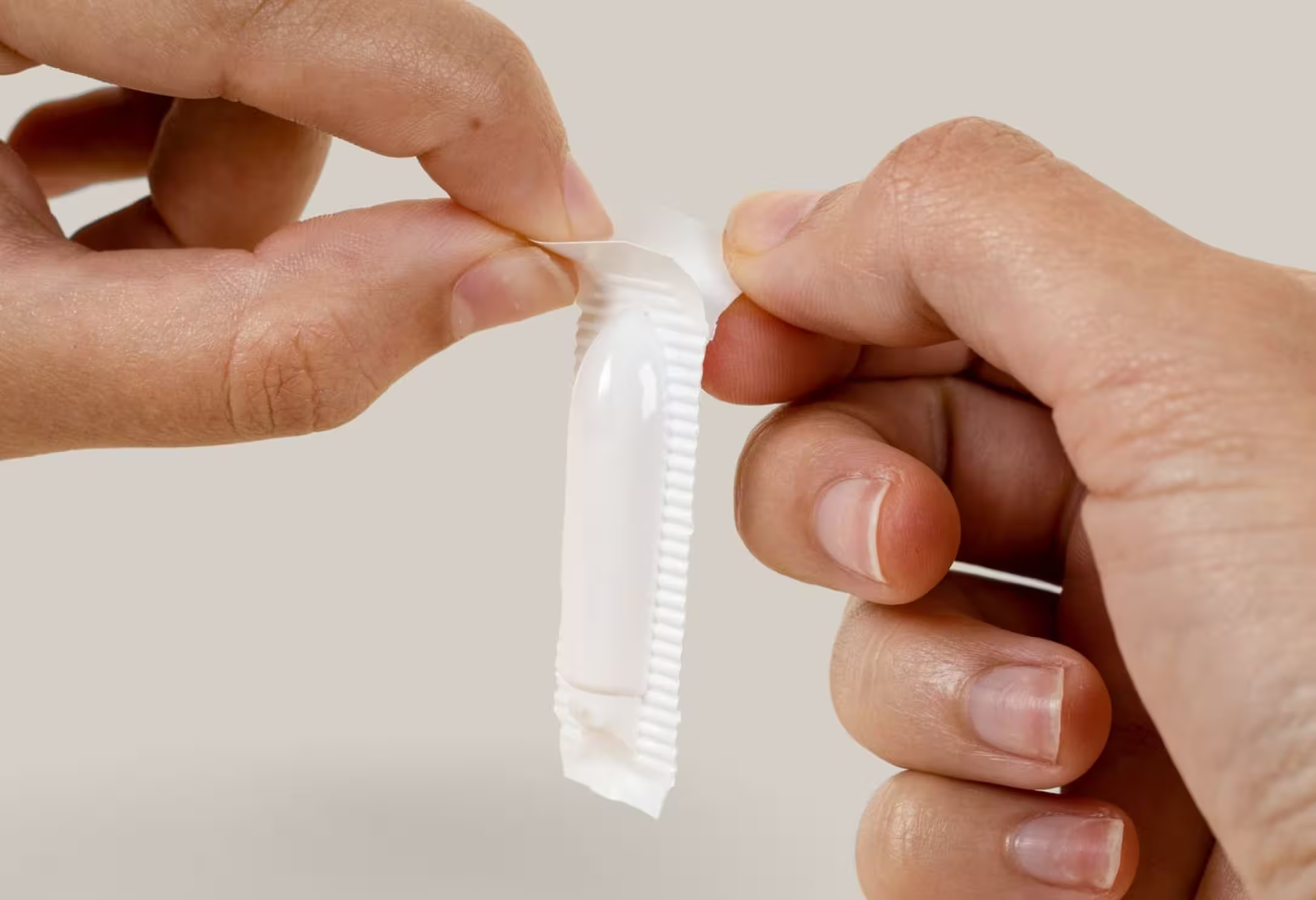

How to Use & Insert Vaginal Suppositories the Right Way
New to vaginal suppositories? Learn how to use them safely and insert them confidently with our easy-to-follow guide.
Words by Olivia Cassano
Scientifically edited by Dr. Krystal Thomas-White, PhD
Medically reviewed by Dr. Sameena Rahman, MD
Treatments for common vaginal health conditions like bacterial vaginosis (BV) or yeast infections often include a suppository.
We know that inserting vaginal suppositories can feel a little bit intimidating, but it doesn't have to be. Below is a full tutorial on how to insert a vaginal suppository, along with some tips on what to expect.
What is a suppository?
There are several ways to take medications: you can take a pill, drink a liquid, or get a shot. Another method is using a suppository, which is a small, round, or cone-shaped object that you insert into your body, usually into your rectum, vagina, or urethra (for men).
Rectal suppositories are bullet-shaped and about an inch long with a rounded tip, used for treating conditions like allergies, constipation, hemorrhoids, or a high fever.
Vaginal suppositories, on the other hand, are inserted into the vagina using either your fingers or a special applicator. Once inside, the warmth of your body melts the suppository and releases the medication, which gets absorbed by the vaginal mucosa and acts locally without too much of the drug entering the systemic bloodstream. Using suppositories isn’t always the most pleasant experience, but they can make it easier to take medicine that you can’t swallow.
They're commonly used as a way to treat vaginal dryness, yeast infections, or bacterial infections like BV. They can include lots of different ingredients, such as:
You should always talk to your healthcare provider before using any treatment in a vaginal suppository because it’s very important to know exactly what’s happening in your vaginal microbiome before you put anything in there, whether it’s prescription or over the counter.

Recurrent symptoms? Get Evvy's at-home vaginal microbiome test, designed by leading OB-GYNs.
How to use vaginal suppositories
Inserting a vaginal suppository can be done either with your fingers or with a plastic applicator.
Always start with a clean space and make sure you wash your hands with soap and water beforehand — you’re dealing with your vaginal area so you want to keep things sanitary!
Using your fingers
Find a comfortable position. You can stand with one foot on a chair, lie on your back with your knees bent, or squat down. Carefully unwrap the suppository and remove the plastic wrap.
Hold the suppository between your fingers with the flat end towards you and carefully push the suppository into your vagina with your dominant hand’s index finger (or middle finger). Aim towards the lower back, not straight up. It should go in about as far as your finger can comfortably reach.
Once you have finished inserting your vaginal suppository, wash your hands thoroughly with soap and water.
Using an applicator
Some suppositories are easier to insert into an applicator if refrigerated, as in the demonstration in the video.
Open the suppository packaging and place the supplement into the applicator. Sometimes you can stand up like this and put your leg on a toilet seat or a chair or a table to gently spread your vulva a little bit so that it's easier to insert the applicator (just like a tampon).
Then, slowly press the applicator until the suppository gets into the vaginal canal. Gently remove the applicator and wash it with mild soap and warm water to avoid contamination.
(If you prefer using an applicator: Dr. Jill Krapf, one of Evvy’s medical advisors, recommends using these ones!)
What to expect during vaginal suppository treatments
It’s helpful to keep in mind when using any vaginal treatments (creams or suppositories) that not all of the medication may be absorbed in your vagina and you may experience some discharge that is either suppository residue or byproduct. This is completely normal.
If your menstrual period begins during the treatment, it is recommended to use sanitary pads instead of tampons and continue the treatment as prescribed.
It can also be normal for our bodies to respond to vaginal medications by producing more of our discharge — this can also be normal. Some people will use a panty liner after they’ve put their suppository in, in case there’s any leakage or extra discharge.
Typical side effects (besides suppository residue or increased discharge) can include mild irritation or itching of the vaginal and vulvar area.
If you experience any moderate to severe reactions to vaginal suppositories such as intense burning or irritation, please seek medical attention.
How long does it take for a vaginal suppository to absorb?
They typically take between 10 to 15 minutes to dissolve, and in some cases, it may take up to 30 minutes. Once the suppository dissolves, the ingredients are absorbed into the bloodstream. The absorption of a vaginal suppository depends on various factors such as the type of suppository, active ingredient, vaginal pH, and moisture level of the vaginal environment, as well as the size and shape of the suppository.
General tips for using vaginal suppositories
- Relax: We know that trying a new treatment can be stressful, but the more relaxed you are, the easier the insertion will be!
- Use cold water or the fridge to prevent suppository melting: If the suppository starts to melt in your hand, rinse it under cold water for a few seconds to harden it back up, or put it back in the fridge for a couple of minutes before insertion.
- Lie down and avoid exercise after insertion: lie down for about 15 minutes after putting the suppository in to allow it to dissolve properly. We recommend using suppositories at bedtime! If you don’t use them at bedtime, try to avoid exercise or excessive movement for approximately one hour after insertion to reduce leakage.
- Trim your fingernails: Some people choose to trim fingernails short and round to help prevent scratches or cuts.
- Avoid tampons: Don’t use tampons when using a vaginal suppository. Tampons can absorb some of the medication, and this can prevent it from working well.
- Don’t force it: If you have trouble inserting the suppository because it feels like you're hitting a wall, it may represent pelvic floor dysfunction and you may want to be seen by a gynecologist.
FAQ
How to use a vaginal suppository?
Wash your hands thoroughly with warm soapy water. Remove the suppository from its packaging, and if it's soft, you can chill it in the refrigerator or run it under cold water to make it firmer. Lie down on your back with your knees bent and legs slightly apart, or stand with one leg raised on a chair — choose whatever position feels most comfortable. Gently insert the suppository into your vagina using either your finger or an applicator if provided, pushing it in as far as it comfortably goes. After insertion, remain lying down to help prevent the suppository from slipping out. Wash your hands again and avoid strenuous activity for a while to allow the suppository to dissolve properly.
How long should you remain lying down after using a vaginal suppository?
It depends on the type of suppository, but it’s generally good to lie down for 10 to 15 minutes (or longer, if possible) to allow the vaginal suppository to dissolve and be absorbed properly. Lying down helps the suppository stay in place and prevents it from being expelled or leaking out before it dissolves and releases the medication into the vaginal canal. We’d recommend following the instructions on the medication leaflet if you’re unsure.
Can I pee after inserting a suppository?
Yes, you can pee after inserting a suppository because suppositories go inside the vaginal canal (not the urethra). That said, we’d recommend peeing beforehand, so you can lie down and give the suppository time to dissolve and absorb without leaking out.
How to insert boric acid suppositories without an applicator?
Hold the suppository between your fingers with the tapered ends towards you. Gently insert the suppository into your vagina using your index finger. Aim towards your lower back rather than straight up, and insert the suppository as far as your finger can comfortably reach.
What happens if you don’t put boric acid up far enough?
If you don’t insert a boric acid suppository far enough into the vagina, you might feel some mild burning, redness, and irritation at the vaginal opening. You might also experience leakage quicker than usual, or the suppository might fall out before it has a chance to melt.
How far up should a boric acid suppository go?
Typically, boric acid suppositories should be inserted approximately 1 inch deep in the vaginal canal.





